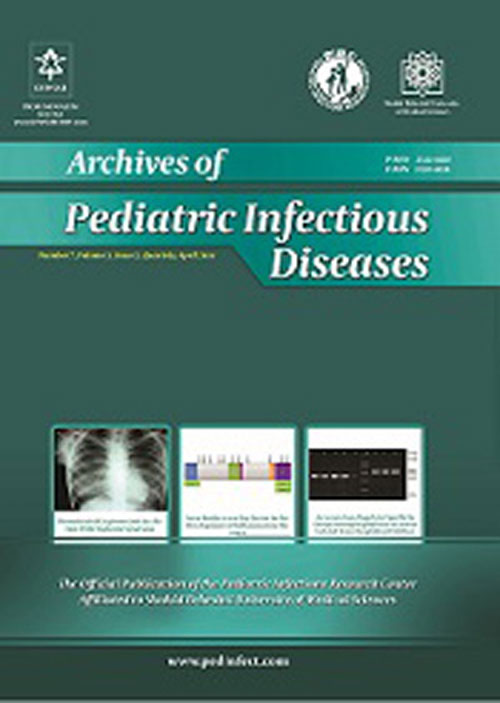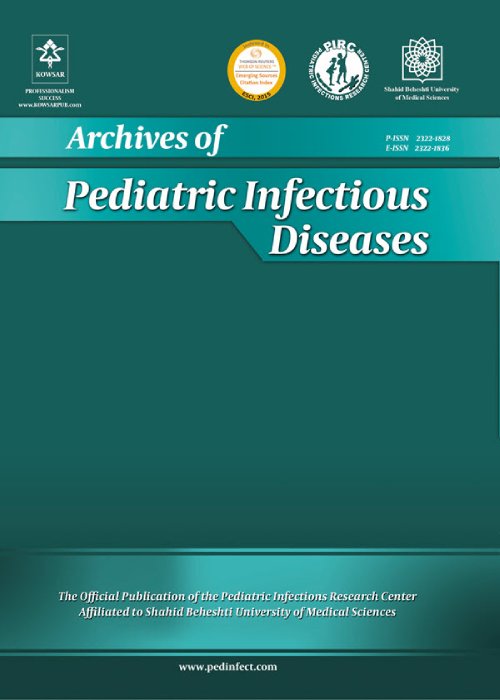فهرست مطالب

Archives of Pediatric Infectious Diseases
Volume:3 Issue: 4, Oct 2015
- تاریخ انتشار: 1394/07/02
- تعداد عناوین: 10
-
-
Page 1IntroductionThere are increasing reports of serious adverse events of bacillus Calmette-Guerin (BCG) vaccination in infants with unrecognized primary immunodeficiency disorders (PIDs) in our country. Among these adverse events skin manifestations occur less frequently and are less noticed..Case PresentationWe report on an 11-months-old boy with prolonged fever and diffuse hyper pigmented subcutaneous nodules. Due to lymphopenia, oral thrush and severe adverse reaction to BCG vaccination, the possibility of primary immunodeficiency was considered for him and immunological investigations were done..ConclusionsSubcutaneous nodules in the absence of a local reaction at the site of BCG vaccination may be the sole manifestation of disseminated BCG disease..Keywords: Mycobacterium Bovis, Skin, Immunologic Deficiency Syndromes
-
Page 3Context: Exclusive breast feeding, (EBF) protects young infants from infectious illnesses; various factors, including pacifier use, may adversely affect the initiation and duration of breast feeding..Evidence Acquisition: Mesh terms relating to EBF were used to search articles published in PubMed between 2000 and 2014. In addition to studies done outside Iran, articles from Iran addressing the issue of pacifier use in infants that had not been published in the PubMed, but were collected from Iranian journals, were also included. Regarding pacifier use, search was limited to papers published during the last 5 years..ResultsRates of breastfeeding at 6 months were reported to vary from 3% to 95% and EBF from less than 1% to 33% in different parts of the world. A negative association between pacifier use and duration of breastfeeding was reported by 10 authors, with a meta-analysis from Turkey reporting a Risk Ratio of 1.952, 95% CI: 1.662 - 2.293. Some researchers, although observed an association between pacifier use and early cessation of EBF, but refuted a causal relationship..ConclusionsAs available data on the effect of pacifier use is conflicting, and continuation of breast feeding till 6 months of age is crucial for optimal health outcomes in infants, it is prudent to avoid pacifier use totally or at least till breast feeding is established..Keywords: Breast Feeding, Infant, Pacifier, Infections
-
Page 4IntroductionAtypical Kawasaki disease (KD) is a diagnostic dilemma. Acute acalculous cholestasis and liver involvement sometimes indicate atypical presentations of KD..Case PresentationWe report a four-year-old boy with fever, abdominal pain, vomiting, jaundice and mild liver enlargement who gradually developed other signs of KD. He was treated by aspirin, intravenous immunoglobulin and finally methylprednisolone pulse therapy with no sequela..ConclusionsKD should be kept in mind as one of the causes of childhood acalculous cholestasis, abdominal discomfort and prolonged fever..Keywords: Jaundice, Kawasaki Disease, Liver, Cholestasis
-
Page 5IntroductionAcute focal bacterial nephritis (AFBN), previously called acute lobar nephronia, is a rare form of interstitial bacterial nephritis in children. The majority of patients with AFBN have an underlying urinary tract abnormality. Timely initiation of appropriate antimicrobial therapy can prevent abscess formation and help avoid the need for invasive surgical procedures..Case PresentationHere we describe a case of a 4-year-old boy admitted for a febrile urinary tract infection (UTI). Radiological investigations led to a diagnosis of AFBN. He was later found to also have a pre-existing malformative uropathy..ConclusionsTimely detection and appropriate antibiotic therapy of AFBN are essential to prevent renal abscess formation. A possible diagnosis of AFBN needs to be considered in all patients being treated for febrile UTI. Detection and surgical correction of the underlying malformation are necessary to prevent further recurrences..Keywords: Nephritis, Urinary Tract Infections, Vesicoureteric Reflux, Child
-
SCCmec Typing of Methicillin-Resistant Staphylococcus aureus: An Eight Year ExperiencePage 6Background
Methicillin resistant Staphylococcus aureus strains (MRSA) are important pathogens that cause serious diseases in humans. Throughout the recent years, the spread of these strains has increased in medical environments and society, and has become a serious challenge in health systems. Therefore, it is vital to investigate the various MRSA types to identify the origins of the infections and to control the spread of these infections in hospitals..
ObjectivesThe current study aimed to evaluate the different SCCmec types in MRSA isolates from hospitals of Tabriz, by staphylococcal cassette chromosome mec (SCCmec) typing..
Materials And MethodsThe present descriptive and retrospective study was performed on 151 selected S. aureus isolates obtained from clinical specimens who were referred to Tabriz university of medical sciences educational-health care centers from April 2005 to September 2012. MRSA isolates were identified by agar disk diffusion and mecA PCR assays. Ultimately, they were typified according to the genetic diversity of the chromosome cassette of SCCmec and ccr regions..
ResultsOf the 151 isolates, 53 were recognized as MRSA. All of these 53 samples were sensitive to teicoplanin and vancomycin. Antibiotic resistance patterns were as follows: azithromycin 56.6%, ciprofloxacin 28.3%, imipenem 11.3%, meropenem 9.4%, ofloxacin 13.2%, ceftriaxone 66%, cotrimoxazole 49.1%, gentamicin 52.8%, linezolid 11.3%, penicillin 90.6%, and rifampicin 5.7%. The majority of MRSA isolates belonged to SCCmec III (69.8%) followed by SCCmec IVc (7.5%), SCCmec IVa (3.8%), and SCCmec I (1.9%). Other types of SCCmec were not observed in the present study. Moreover, from the 53 MRSA samples, 9 were recognized as non-typable. However, staphylococcal cassette chromosome recombinase (ccr) genetic complex analysis revealed that among the 53 studied samples, 4 isolates had ccr type 1 pattern, and 11 and 32 isolates had ccr type 2 and ccr type 3 pattern, respectively. Furthermore, 6 isolates were considered as non-typable with ccr -typing..
ConclusionsAs about 70% of methicillin-resistant isolates belonged to SCCmec III, the present study can conclude that, over an 8-year period, only one dominant and stable clone of MRSA strain was found in Tabriz hospitals. This finding could be a result of incorrect medical orientations, inadequate infection controlling policies, and insufficient preventive approaches..
Keywords: MRSA, SCCmec Typing, ccr Typing, Multiplex, PCR -
Page 7BackgroundThe incidence rate of acute diarrheal disease in children is a health indicator, and the estimation of these data can help guide public health policies..ObjectivesThe aim of this study was to estimate the incidence and risk factors for acute diarrheal disease in children aged 0 - 1 year..Patients andMethodsAn observational prospective cohort study was conducted on 210 children recruited at Hospital Nossa Senhora da Conceicao, in Tubarao, state of Santa Catarina, Brazil. Children born between July and September 2012 were followed up for 12 months. The presence of three or more liquid or loose stools during a 24-hour period was considered acute diarrhea. The categories of variables evaluated were comprised of sociodemographic characteristics (per capita income, maternal education, maternal age, access to medical care [public or private], and housing and living conditions [sanitation and hygiene, water supply, daycare attendance, and domestic animal]) and characteristics of the child (gender, birth weight, and breastfeeding)..ResultsThe incidence of acute diarrhea among the 0 - 1-year-old children was 26.7 cases per 1,000 children per month. Independent risk factors for the occurrence of diarrhea were maternal age under 20 years and health care services provided by the Brazilian National Health System (SUS)..ConclusionsThe high incidence density of diarrhea among the children recruited in this study indicates the need for educational programs directed at people who are involved in this issue..Keywords: Diarrhea, Children, Risk Factors
-
Page 9BackgroundCandida colonization is a major risk factor for invasive candidiasis in premature infants in the neonatal intensive care unit (NICU)..ObjectivesThe purpose of this study was to determine the rate, risk factors, and sources of colonization in low birth weight (LBW) and very low birth weight (VLBW) infants in an NICU..Patients andMethodsAll cases were classified in to 1 of 2 groups: LBW and VLBW. A questionnaire that collected demographic data was completed for each case. Swabs were obtained from the ear, umbilicus, and rectum, as well as catheters, tracheal tubes, and nasogastric tubes. Samples were cultured on Sabouraud dextrose agar. The data were analyzed using SPSS software. A P value < 0.05 was considered significant..ResultsA total of 102 cases were examined in this study. The mean weight of the infants was 1720 ± 474 gr (range 850 - 2500 gr). Positive Candida cultures were isolated in 19 (31.7%) cases in the LBW group and 20 (47.6%) cases in the VLBW group. In addition, 36 (35.3%) cases showed signs of sepsis. The mortality rate was 1.7% (n = 1). The umbilicus and rectum were the most common sites for Candida colonization in both groups. The analysis also indicated that the duration of hospitalization, prolonged use of corticosteroids, central venous catheters, total parenteral nutrition, and mechanical ventilation were associated with candidiasis infection in VLBW infants while prolonged use of corticosteroids and central venous catheters were major risk factors associated with candidiasis infection in LBW infants..ConclusionsThese results show that maturity and birth weight are related to a decrease in the risk of developing a candidiasis infection..Keywords: Candida, Neonatal Intensive Care Units, Risk Factor


